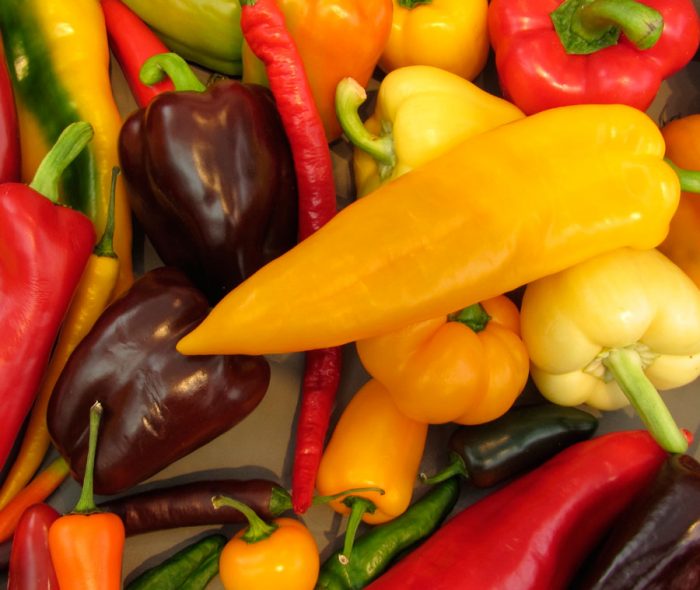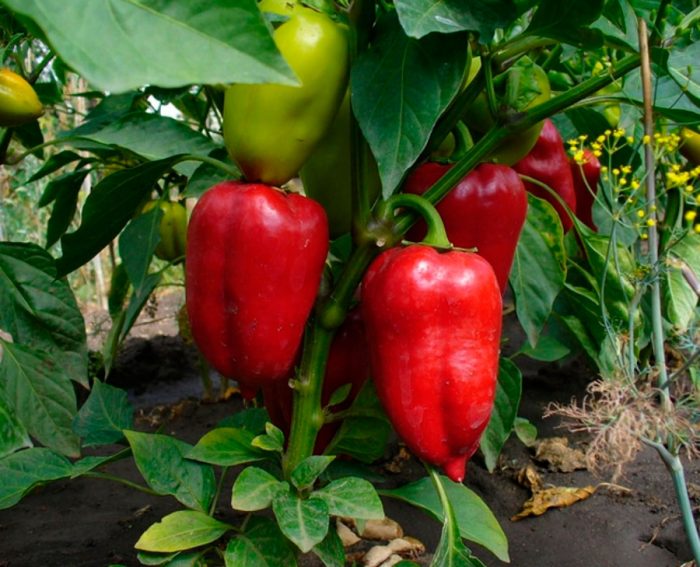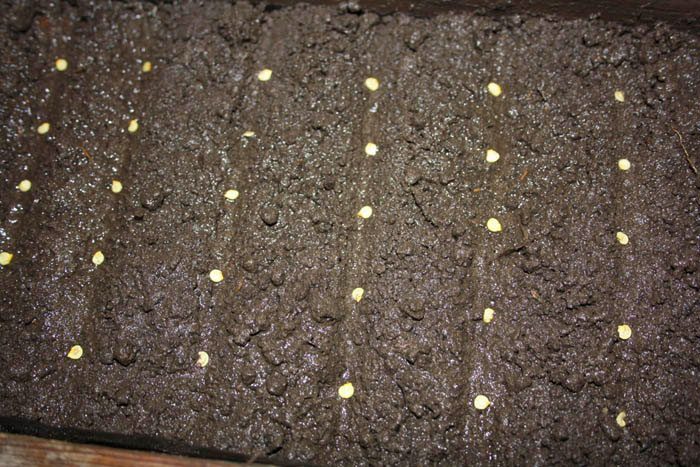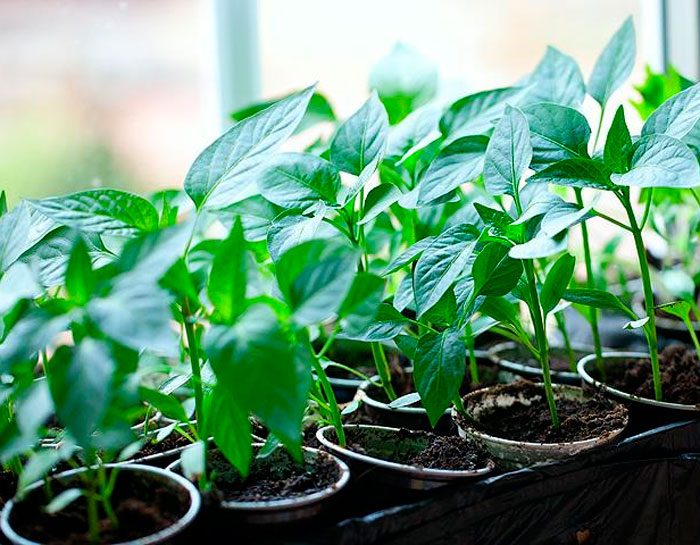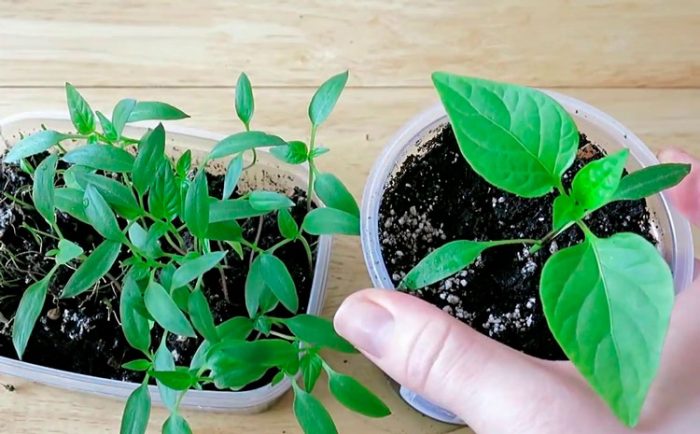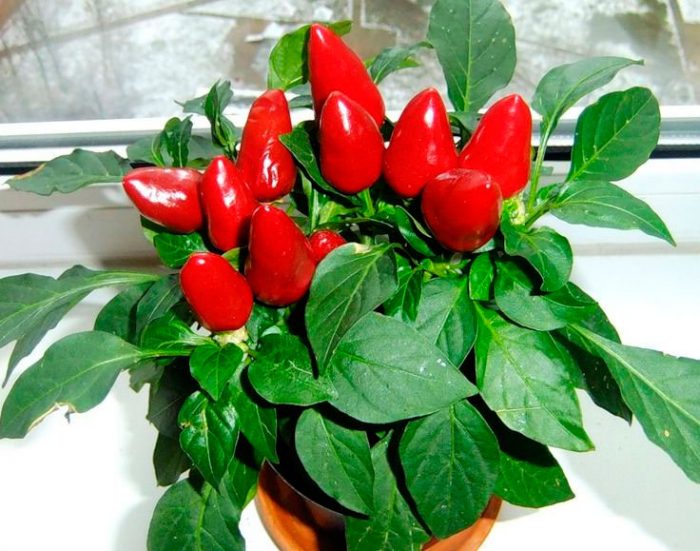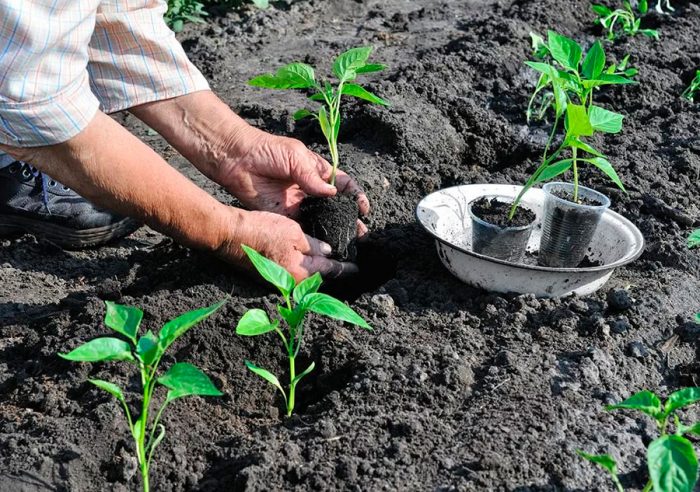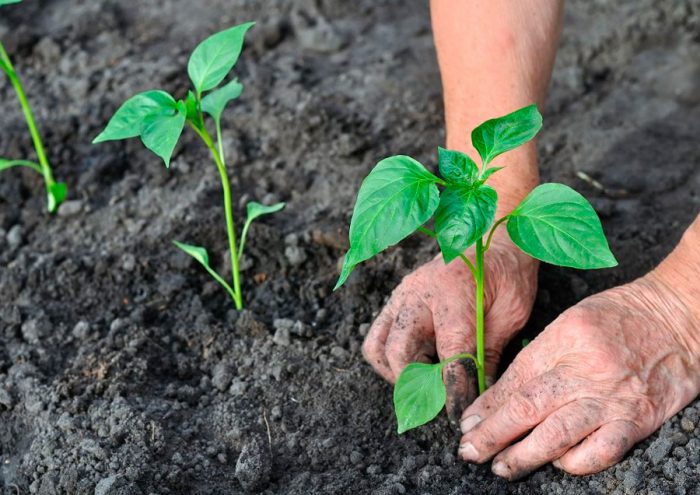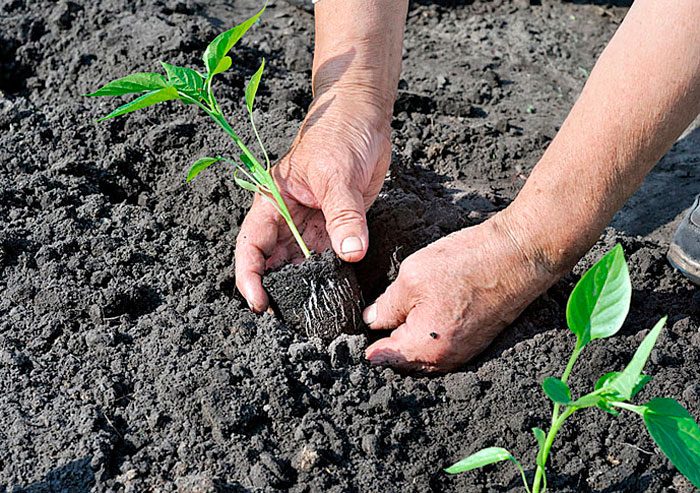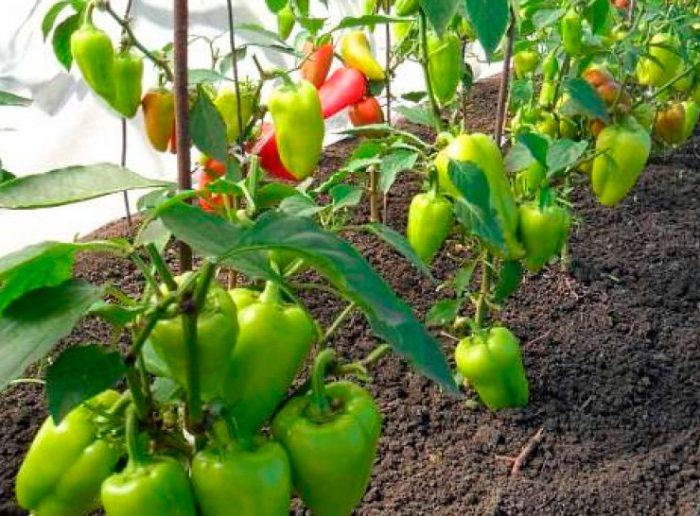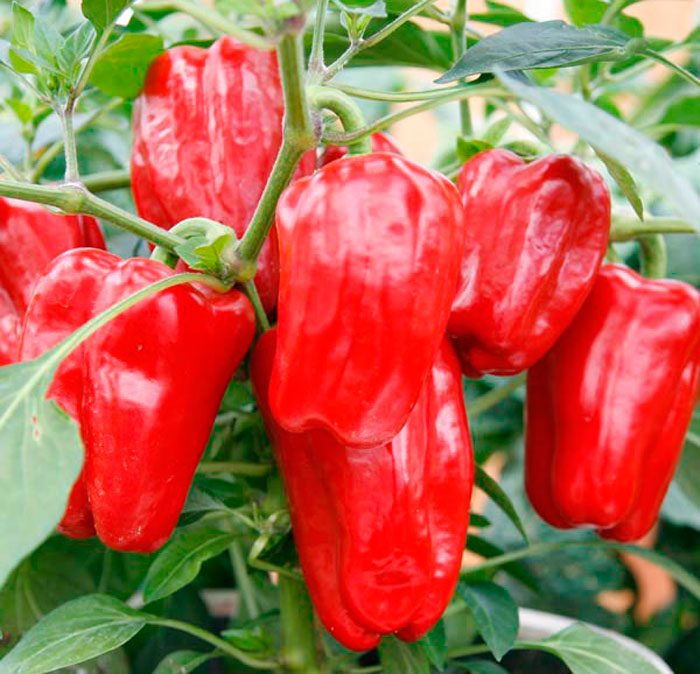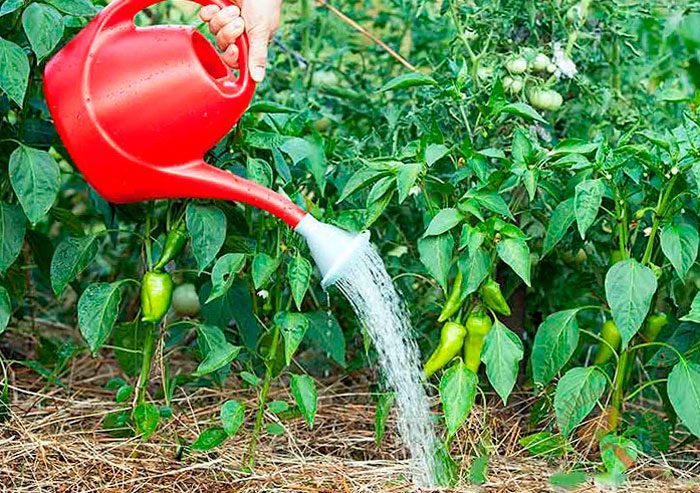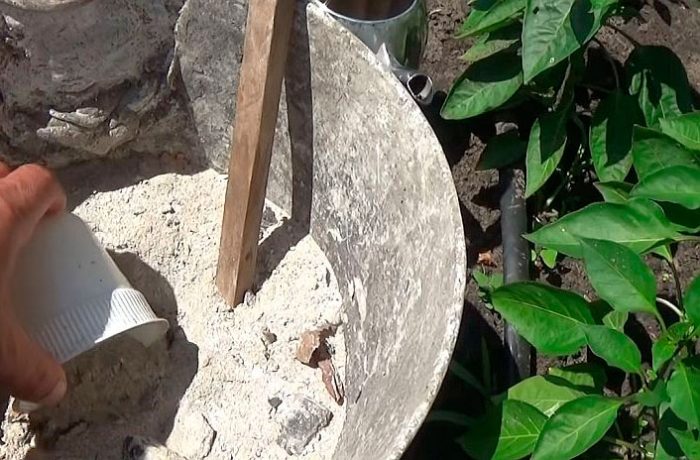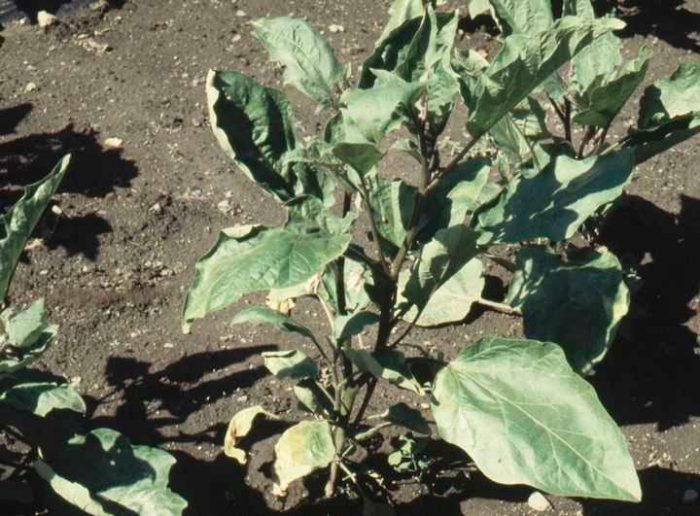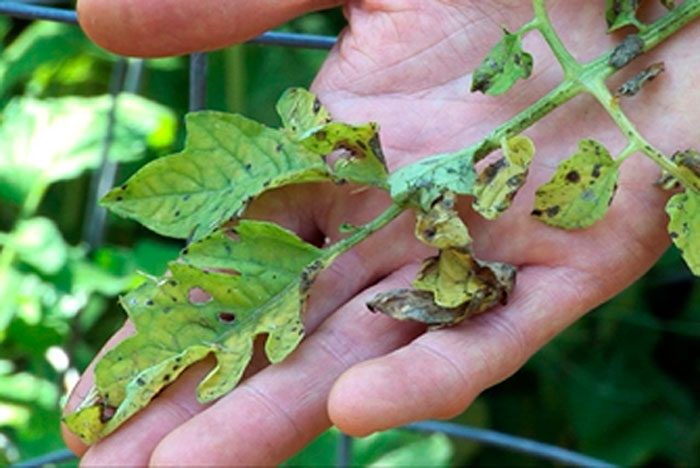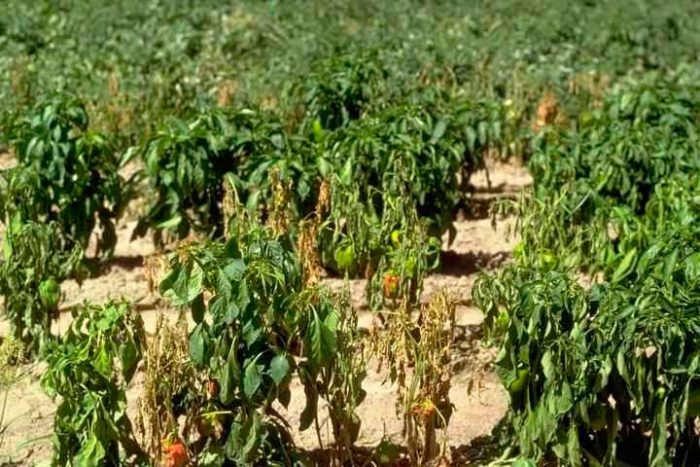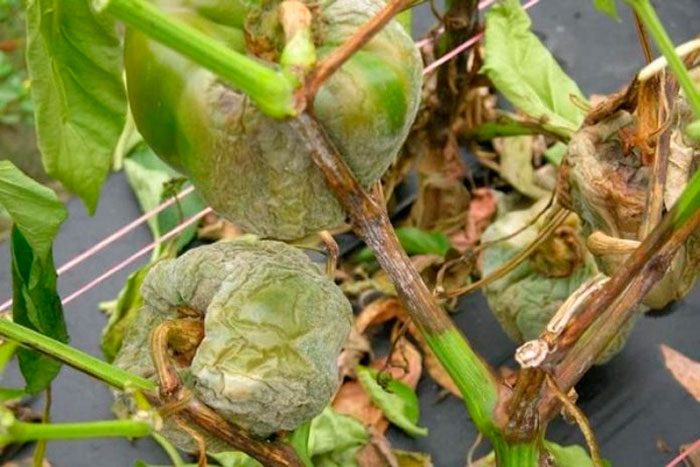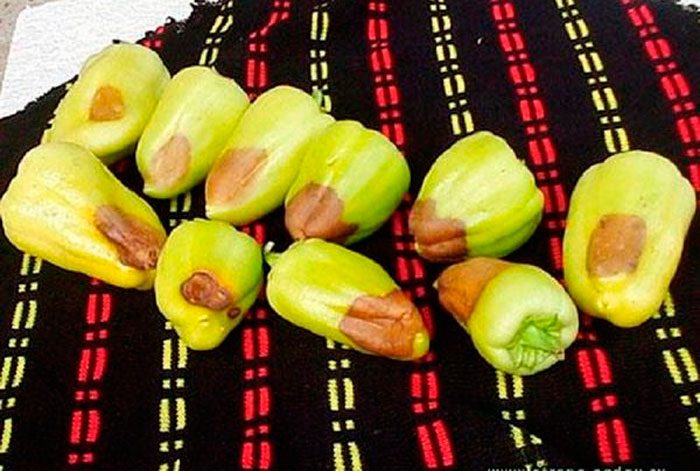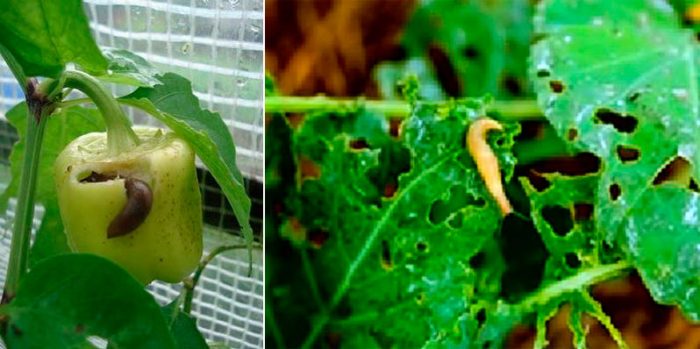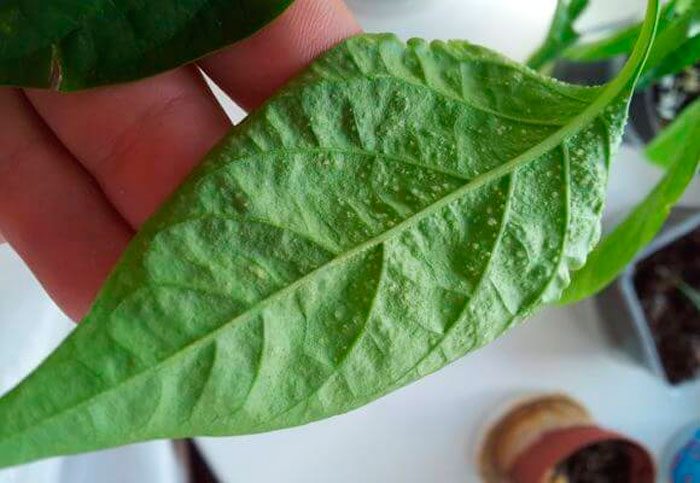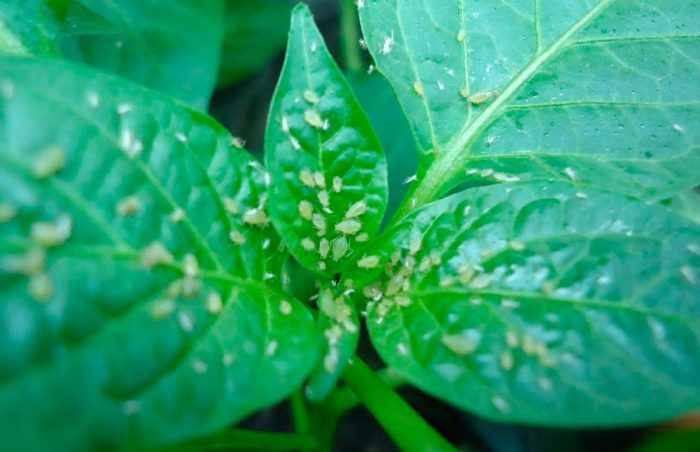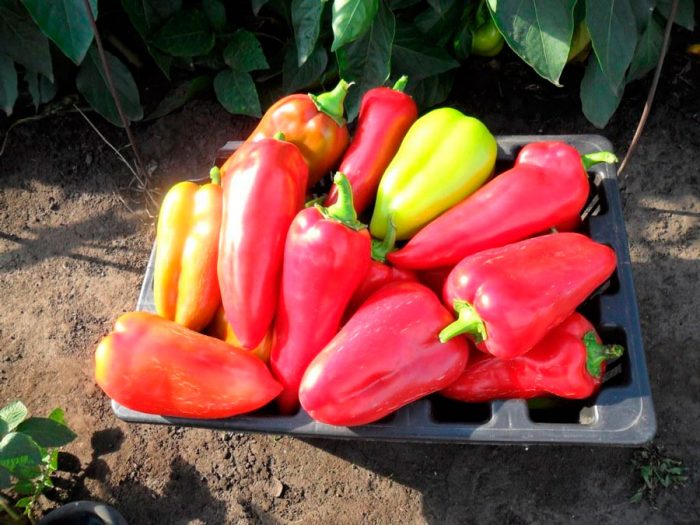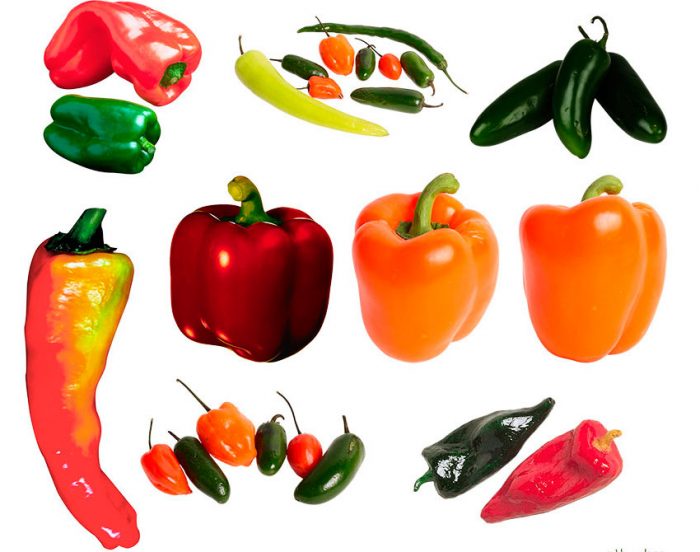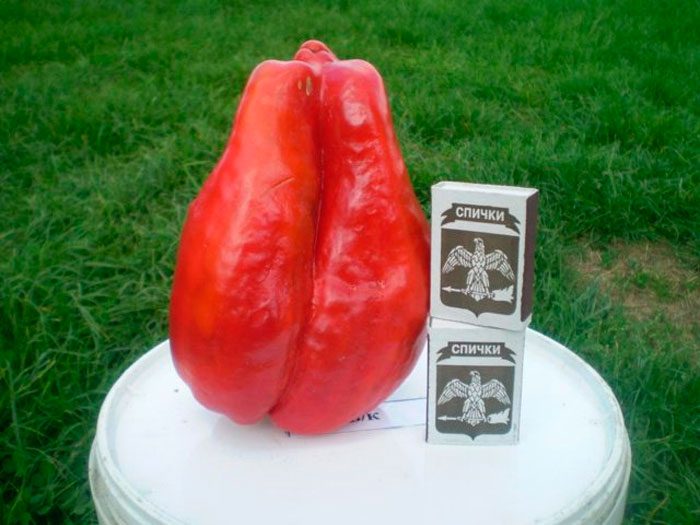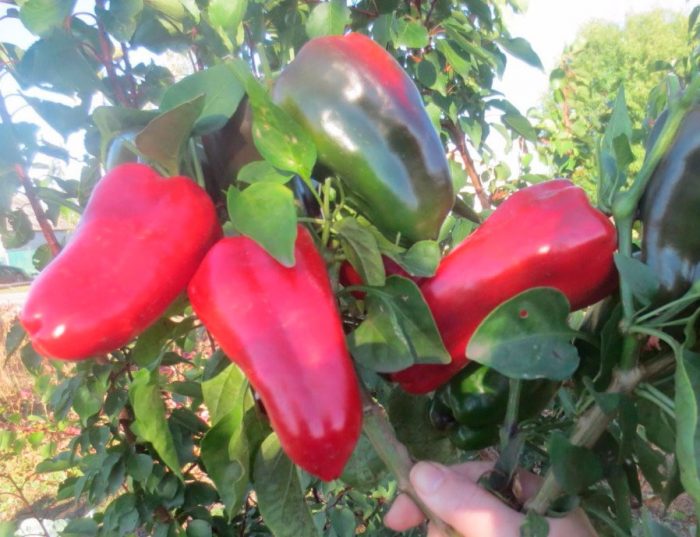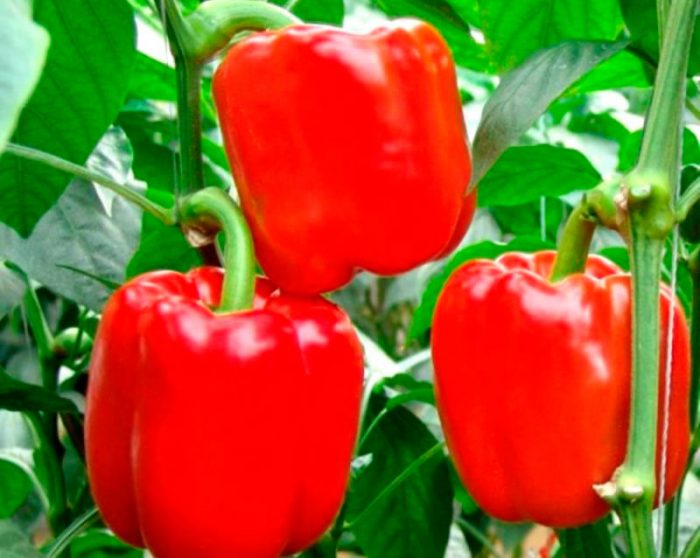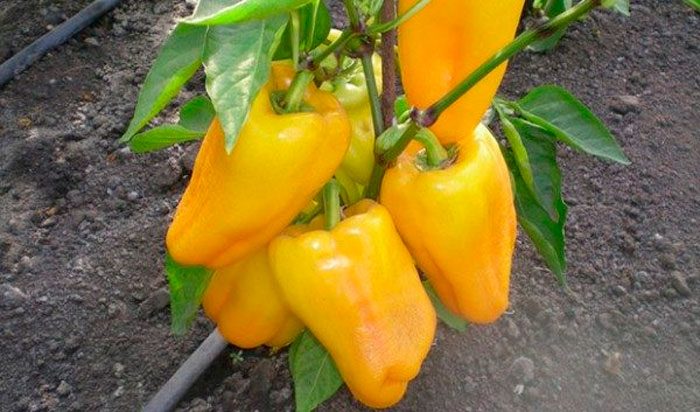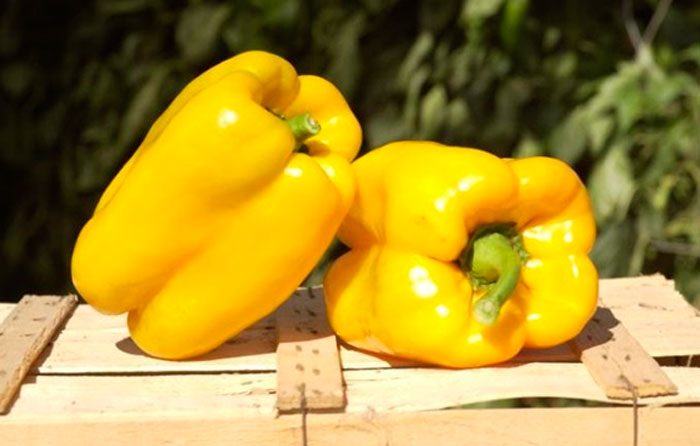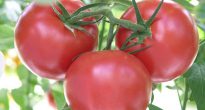The herbaceous annual plant paprika (Capsicum annuum) is a member of the genus Capsicum of the Solanaceae family. Such a culture is widely cultivated in agriculture. The homeland of pepper is Central America, such a vegetable appeared in Europe in the 15th century and, despite the fact that such a culture is demanding to care for and thermophilic, it has gained immense popularity among gardeners in a short time. Today there are about 2 thousand varieties of paprika, most of them are related to the subspecies of sweet pepper, and the rest - to the subspecies of bitter pepper. Below we will talk about sweet peppers.
Content
Pepper features
Sweet pepper, also called bell pepper, is an annual vegetable crop; in natural conditions, such a plant is a perennial shrub. Petiolate simple leaf plates are single or assembled into an outlet. The color of the foliage varies by cultivar and variety, and comes in various shades of green. Large axillary flowers are single or included in bunches, the corolla is painted in purple, white or pale green. The fruit is a hollow, false, multi-seeded berry that has a variety of weights, shapes and sizes, and can be colored orange, red, yellow or brown.
Growing pepper from seeds
Sowing
Bell peppers in mid-latitudes are most often grown through seedlings. Depending on climatic conditions, the sowing time may vary, but in any case, you need to sow seeds no later than the first days of March.
The seeds of such a culture must be prepared before sowing. First, they are immersed in slightly hot (about 50 degrees) water for swelling, where they should stay for 5 to 6 hours, after which they are placed in a moist cloth and removed to a warm place (about 20 degrees), where they should stay 2-3 days. Seeds that have hatched can be sown into the substrate. Such sowing material sprouts much faster than unprepared one, so usually seedlings appear two or three days after sowing them in soil mixture.
You can prepare a substrate for sowing with your own hands, for this you need to combine 1 tbsp. sand, 2 tbsp. garden humus, 1 tbsp. garden land, 1-2 tbsp. l.wood ash, everything should be mixed well and then disinfected. For this, the soil mixture is calcined in a microwave or oven and, while hot, is laid out in containers. Smooth the surface of the substrate and wait until it cools down to 40–45 degrees, after which it is necessary to evenly distribute the seeds in the containers, keeping a distance of 50 mm between them. They must be buried in the substrate only 15–20 mm. However, experts recommend using peat pots for sowing, since this culture reacts negatively to picking. When the sowing is completed, the substrate in the containers must be thoroughly moistened, and they must be covered with glass or polyethylene on top, after which they are transferred to a warm place (about 21 to 22 degrees).
Seedling care
It is necessary to care for the seedlings of such a plant in the same way as for the seedlings of any other culture. After the first shoots appear, the peppers need to provide the following temperature regime: at night - from 10 to 15 degrees, and in the daytime - from 26 to 28 degrees. Provide the plants with such a watering regime so that the substrate in the containers is constantly moderately moist, remember that stagnant water in the soil mixture is the cause of the development of blackleg. Overdrying of the soil mixture should not be allowed either. For watering, you must use well-settled tepid (about 30 degrees) water. If cold water is used for these purposes, then the plants will wither, ache and eventually die.
Pepper seedlings need high air humidity; therefore, it is recommended to systematically moisten it from a spray bottle. In addition, the room where the peppers are located must be systematically ventilated, but it is imperative to protect the seedlings from drafts. You also need to take into account that such plants need a long day of light (from 7 am to 9 pm), in this regard, if necessary, they need to organize additional lighting.


Watch this video on YouTube
Seedling picking
A pick of seedlings is carried out when the formation of the first pair of true leaf plates is observed in them. Peppers grown in peat pots do not need a pick. And you need to dive the seedlings that grow in a common container, for this they use separate peat pots measuring 8x8 centimeters, when planting the plants in the substrate, they must be buried in cotyledon leaves. The established seedlings should begin to actively grow and develop. Before proceeding with transplanting peppers into open soil, they must be hardened. To do this, every day the plants need to be transferred to the street, while the duration of this procedure must be increased gradually. Remember that during hardening the plants should not be exposed to drafts, and they should also be protected from frost (the air temperature should not be less than 13 degrees).
During the cultivation of seedlings, it must be fed at least 2 times before transplanting to the garden bed. The first feeding is arranged half a month after the pick or during the formation of the first pair of true leaf plates in the plants. The second feeding is carried out 15 days after the first or during the formation of a second pair of true leaf plates in the seedlings. It is recommended to feed the peppers with liquid fertilizers. It is best to use Solution, Fertika Lux, Agricola or Krepysh for feeding seedlings.
Growing pepper on a windowsill
Bell peppers can be grown on your windowsill, but for this you should prepare: seed of a self-pollinating variety, phytolamp, suitable soil mixture, and also choose a place that is illuminated by the sun for at least 3-4 hours a day. After the bushes in the pots begin to bloom, it is advisable to shake them well once a day, this contributes to a more successful fruit setting. A large number of fruits growing on a bush take away a lot of energy from the plant, in this regard, you need to choose only 5 or 6 ovaries, and cut off the rest.
Fruit crops grown in a pot contribute to the rapid depletion of the substrate, in this regard, such bushes must be fed regularly. This is done once every 15–20 days, for this, the soil mixture is watered with a solution of Rost (1 cap of the preparation for 2 liters of water) or 1 tsp is added to the top layer of the soil mixture. agrolife.
The pepper grown on the windowsill is a perennial, therefore, it is recommended to add fresh vermicompost to the container once every 2 months (as long as the volume of the pot allows), or when it is necessary to transplant the plant into a larger container. In order for the bush to grow well and bear fruit, every spring it does not need a very large anti-aging pruning. If everything is done correctly, then one plant will bear fruit for several years.
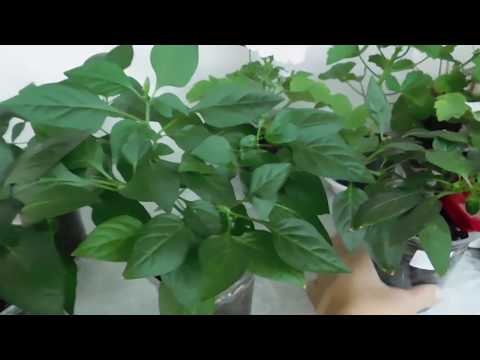

Watch this video on YouTube
Planting pepper in open ground
What time to plant
When the pepper seedlings get stronger and grow up, it must be hardened. It is planted in open ground during the formation of the first buds, after the air outside warms up to 15-17 degrees. As a rule, planting of seedlings in open soil is carried out from the last days of May to the second half of June.
Pepper primer
A non-acidic light soil is suitable for such a plant. Preparing the site for planting should be done about 12 months before the day of planting seedlings. At the same time, in this area, you can grow crops that are good predecessors for peppers, for example: zucchini, onions, green manure, cucumber, carrots or pumpkin. And in the area where nightshade crops were previously grown, for example, potatoes, peppers, eggplants, tomatoes or physalis, sweet peppers cannot be grown. For planting peppers in spring, 1 year before, 5 kilograms of organic fertilizer per 1 square meter of the plot should be added to the soil during digging under the predecessors. In the autumn, when the harvest is harvested, the site is digged, while 50 grams of potash and phosphorus fertilizers are applied per 1 square meter.
In the year of planting pepper seedlings in spring, 40 grams of ammonium nitrate per 1 square meter are introduced into the topsoil. When 5 days remain before transplanting seedlings into open soil, the site should be spilled with a disinfectant solution; for its preparation, 10 liters of water must be combined with 1 tbsp. l. copper sulfate.
Landing rules
The distance between the holes on the bed should be from 0.4 to 0.5 m, while the row spacing should be about 0.6 m. The depth of the planting hole should be made such that after planting the plant, its root collar is flush with the surface of the site. Pour 1 tbsp into each hole. l. complete mineral fertilizer, which must contain potassium, nitrogen and phosphorus. Fertilizer should be thoroughly mixed with the soil at the bottom of the planting hole.
Peppers grown in peat pots must be immersed in the hole along with the container. When growing seedlings in a box, the plant is carefully pulled out of it, while trying to keep the clod of earth intact, then it is placed in the planting hole. The well should be filled ½ part with the nutrient mixture. Planted peppers need abundant watering, while 10 liters of water are taken for 3 bushes. After the water is completely absorbed into the soil, the hole should be filled up to the top with soil. It is recommended to cover the surface of the site with a layer of mulch (peat). If at night outside the air temperature is below 13 degrees, then the seedlings transplanted into the open ground will need shelter.
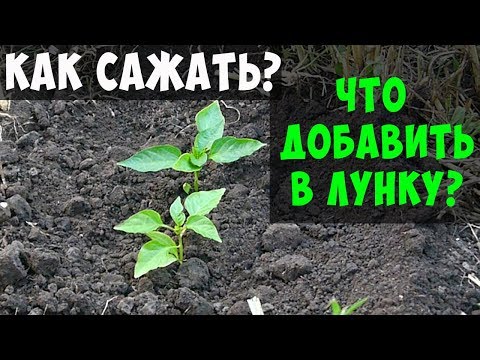

Watch this video on YouTube
Growing pepper in a greenhouse
There are varieties of sweet peppers intended for growing in open soil, and there are those that can only be grown in greenhouses, for example, varieties: Arnes, Accord, Alyonushka, Vesper, Bonus, Atlant, Buratino, Orange Miracle, Tenderness, Swallow, Nochka and dr.
To begin with, they sow seeds for seedlings. The grown plants should be hardened on the terrace or balcony, and then they must be transplanted into the greenhouse. How to sow seeds and grow seedlings is described above.Planting seedlings in greenhouse soil is carried out after the height of the plants reaches 25 centimeters, while their age should be at least 55 days. Also, the plants should have a thick green stem and 12-14 leaf plates, while the leaf axils should have already formed buds. You can plant peppers in an unheated greenhouse only after the soil in it warms up to at least 15 degrees. That is why most often the disembarkation time falls approximately in the second half of May.
Before planting seedlings, fertilizers must be applied to the greenhouse soil: 40 grams of phosphorus and 30 grams of potash fertilizers are taken per 1 square meter of the plot. Then the soil must be watered well. Depending on the variety, the following distance should be observed between the bushes: for low-growing early varieties - about 15 centimeters, for medium-sized ones - about 25 centimeters, and for strong-growing ones - at least 35 centimeters. The row spacing can vary from 0.35 to 0.6 m. When the seedlings are planted, the soil in the holes must be tamped down and covered with a layer of mulch (peat).
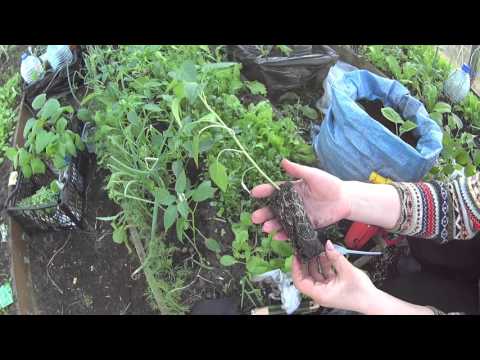

Watch this video on YouTube
Pepper care
To grow sweet peppers in open soil, the bushes need to be watered, fed, tied up in time, and you also need to regularly loosen the soil surface and remove weeds. In order for the bushes to give more fruit, it is recommended that they tear off the central flower from the first branch. Also, the plant will be more productive if it is formed into 2 or 3 stems, and for this you need to cut off extra stepsons (side shoots) in time. The formation of bushes can only be carried out in wet and sultry weather. It should be borne in mind that no more than 20-25 fruits should be left on one bush. When growing tall varieties during planting of seedlings, a peg is placed near each bush, to which the plant is tied, if necessary.
Peppers are pollinated with the help of pollinating insects, which, if necessary, can be attracted to the site. For this, the plant must be treated with boron-sugar syrup from a spray bottle; for its preparation, it is necessary to dissolve 100 grams of granulated sugar and 2 grams of boric acid in 1 liter of hot water. You also need to take into account that when the pepper is blooming, it cannot be treated with toxic chemicals, as this can lead to the death of pollinating insects.
How to water
Peppers planted in open soil may at first have a sluggish appearance, but there is nothing wrong with that. The main thing is to prevent stagnation of water in the ground at this time, as this can cause bushes to suffer greatly. Before the bushes bloom, they will need rare watering (once every 7 days). During the formation of fruits, the number of watering must be increased up to 2 times in 7 days, while 6 liters of water must be taken per 1 square meter of the plot. When the peppers are watered, the surface of the soil around them must be very carefully loosened, while trying not to injure their superficial root system.
Watering such a culture with well-settled lukewarm water from a watering can by sprinkling. If the pepper does not have enough water, then due to this, growth retardation can be observed, as well as the dropping of ovaries and flowers. In order to reduce the number of irrigations, the soil surface should be covered with a layer of mulch (rotted straw), the thickness of which should be about 10 centimeters.
Fertilizer
In the process of growing pepper in open soil, it must be fed 2 times with a solution of chicken manure (1:10). The bushes will also need top dressing on foliage, for this, a solution of nitrophoska is used (for 10 liters of water 1 tbsp. L. Substance).
If the peppers do not have enough potassium, then their foliage curls and a dry border appears at the edges, but it should be remembered that it is forbidden to feed them with potassium chloride, because this culture reacts extremely negatively to chlorine. If there is little nitrogen in the soil, the leaf plates become dull, then acquire a grayish tint and become smaller. And when the soil is oversaturated with nitrogen, flowers and ovaries shatter near the bushes.If there is little phosphorus in the soil, then the seamy surface of the foliage is painted in a bright purple color, and the plates themselves rise up and squeeze against the stems. As a result of a lack of magnesium, the foliage of the bushes takes on a marbled color. Inspect the bushes regularly and as soon as signs are noticed that the plant is lacking this or that element, feed them using the necessary fertilizer.
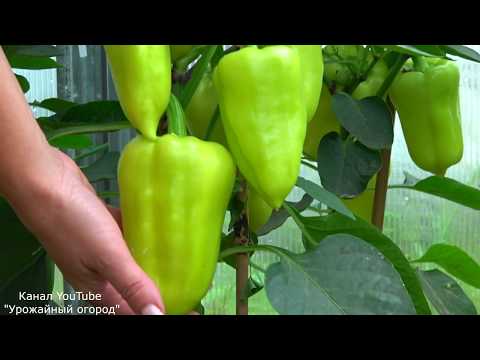

Watch this video on YouTube
Treatment
During the ripening of fruits, it is not recommended to use chemicals to fight various diseases, because the harmful substances contained in them can accumulate in peppers. If you take care of this crop correctly and follow all agrotechnical rules, then there is a high probability that the bushes will not get sick at all, and various pests will not settle on them. However, if problems do arise, then all necessary measures must be taken in a timely manner.
Diseases and pests of pepper with photo names
Diseases
Bell pepper can strike: verticillus (wilting), bronze (spotted wilting), phytoplasmosis, fusarium, late blight, apical and gray rot, black leg.
Verticillosis
Verticillosis is a fungal disease that has 3 forms: green, brown and dwarf. Moreover, each of these forms manifests itself in different ways. Since it is better to avoid the treatment of peppers with chemical preparations, it is recommended to adhere to the necessary preventive measures: in the autumn, it is necessary to clear the site of plant residues, which are necessarily burned, and for cultivation, you should choose varieties that are resistant to this disease.
Phytoplasmosis
If the bushes are affected by phytoplasmosis (stolbur), then rot appears on their root system, the development of dwarfism is observed, the fruits become smaller, and also become tasteless and thin-walled, curling, hardening and yellowing of the foliage are observed, and in the end, the plant dies. The carriers of this disease are leafhoppers. To get rid of phytoplasmosis, the bushes need to be sprayed with Akara's solution during planting seedlings in open soil and 20 days after that, at this stage of development, the plants are not harmed by pesticides. In addition, it is necessary to systematically loosen the surface of the soil, as well as remove all weeds in a timely manner.
Fusarium
When pepper is affected by such a fungal disease as fusarium, its yellowing is observed, namely, the foliage changes its color to poisonous yellow. Sick bushes need to be dug up and burned, the rest of the plants must be very well looked after, for this they will need moderate watering, which is carried out in the morning, and it is also necessary to pull out all the weeds in time. The area that is infected with late blight pathogens cannot be used for growing sweet peppers for at least 1 year.
Late blight
A fairly common fungal disease is late blight, which affects tomatoes and peppers. In diseased bushes, hard spots form on the surface of the fruit, which capture the pulp. Such bushes must be sprayed with a solution of Zaslon, Oxychom or Barrier, but only before the bushes bloom. It should be borne in mind that hybrid varieties are more resistant to diseases.
Blackleg
Pepper seedlings are usually sick with a black leg. In the bushes, the root part of the stem is affected, the development of such a disease is facilitated by excessively dense sowing and non-observance of the rules for growing seedlings, namely, content with high humidity and substrate. As the disease progresses, the stem becomes soft and the plant dies. In order to prevent such a fungal disease, thickening of the seedlings should not be allowed, it is necessary to pick them in a timely manner, and also maintain the required level of humidity in the greenhouse. If affected plants are noticed, they should immediately be pulled out and burned, the surface of the substrate should be loosened, dried and sprinkled with wood ash. Then the seedlings need to be treated with the Zaslon solution (three caps of the product are needed for 1 liter of water).
Vertex rot
The development of top rot occurs due to the fact that the plants lack moisture.In affected peppers, deep black or glossy spots appear on the surface of the fruit. In some cases, the development of the disease begins due to the fact that the soil contains too much calcium and nitrogen. The affected bushes must be destroyed, and the remaining ones must be treated with calcium nitrate.
Gray rot
Peppers can be affected by gray mold at any stage of development. A diseased bush has putrid specks and a mold of gray color. As a rule, the active development of such a disease is observed in wet weather. The affected parts of the bush, as well as the fruits, must be destroyed, then the peppers are treated with a fungicidal preparation. But this is only if the plants are not very strongly affected.
Spotted wilting
Also, peppers can get sick with spotted wilting, or bronze, while specks of brown appear on the leaf plates, which eventually turn purple or bronze. Most of these necrotic spots appear along the central vein of the leaf blades. Over time, the top of the bush dries up, while the fruits in the area of the stalk are covered with ring specks of brown, green or yellowish color. To save the harvest, it is necessary to pluck all ripe fruits, as well as stop all watering. To cure infected bushes, they need to be sprayed with Fundazole, but one should not forget about the dangers of fungicides that they bring to adult bushes.
Pests
Spider mites, slugs, aphids or wireworms can settle on the bushes of such a plant.
Slugs
So that the peppers do not suffer from slugs, the surface of the site must be covered with a layer of hot pepper, nut shells or mustard powder. You can also make traps, for this in several places on the site you need to put bowls filled with dark beer, they will attract pests, which you just have to collect and destroy. You also need to remember that on hot days it is necessary to loosen the soil surface between the rows to a depth of 40 to 50 mm.
Wireworms
Wireworms are the larvae of the click beetle. They live in the ground for 5 years and gnaw the roots of bushes. To clear the site of such a pest, in the autumn, you should dig it up, and in the spring, before planting pepper seedlings on it, you need to make several baits. To do this, bury pieces of sweet root vegetables in different places on the site, and do not forget to put marks on these areas. Such baits are good at attracting wireworms. Once every two or three days, root crops must be dug up and pests must be collected, which are then destroyed.
Spider mites
Spider mites settle on peppers during the dry season, while they settle on the seamy surface of the leaf plates, and feed on cell sap. To get rid of a tick, you can use insecticidal preparations specially designed for this, but it is best to use a self-made product, for this, 1 tbsp is poured into 1 bucket of water. finely chopped onion or garlic, and add 1 tbsp. l. dishwashing detergents or liquid soap, and finely cut dandelion foliage. After the mixture is infused, it must be used to process pepper bushes.
Aphid
To destroy aphids, it is necessary to use a special infusion for spraying the peppers, for the preparation of which you need to combine 1 bucket of hot water and 1 tbsp. tobacco dust or wood ash. Plants can also be sprayed with Keltan or Karbofos, which are rapidly decomposing insecticidal preparations; to prepare a solution, you must combine 1 bucket of water with 1 tbsp. l. substances.
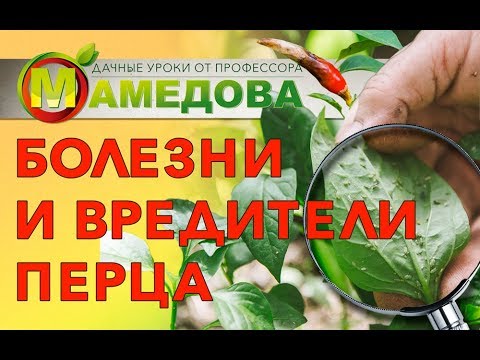

Watch this video on YouTube
Collection and storage of peppers
Pepper has 2 types of ripeness, namely: technical and biological (physiological).When the fruits are at the technical maturity stage, they are usually colored in various shades from greenish-whitish to dark green. At the stage of biological maturity, the fruits are colored red, purple, yellow or brown, after harvesting they must be eaten or preserved as quickly as possible, as they spoil very quickly. If the fruits are harvested at the stage of technical maturity, then under optimal conditions they will be able to maintain their freshness for 8 weeks. The time difference between technical and biological ripeness is from 3 to 4 weeks.
To understand whether the fruit is ready for collection or not, you need to lightly press on it, if you hear a crack, then you can pick the pepper. Experienced gardeners collect peppers at the same time as harvesting tomatoes and eggplants. As a rule, the first fruits begin to be harvested in the first half of August. Harvesting can continue until frost. Usually ripe fruits are picked every 5-7 days. Peppers cut with a stalk are much better stored. During the growing season, the fruits are harvested 3-5 times. Before freezing, you need to harvest the entire crop. The fruits must be sorted by size and degree of ripeness, after which they must be left to ripen.
Before storing the peppers, the stalk should be shortened, while the length of the remaining segment should be from 10 to 15 mm. You can store only completely healthy thick-walled peppers, on the surface of which there is no mechanical damage. Thin-walled fruits are placed in the refrigerator for storage. To store varieties with juicy walls, you can use polyethylene bags, the thickness of which should be at least 120 microns, very well if they have a membrane with perforation on the side wall. To keep the peppers better, each of them must be wrapped in a paper sheet.
For storage, fruits can be placed in not very deep boxes for 1 or 2 rows, in a basket or on a shelf in the basement, the air humidity in which should be from 80 to 90 percent, and the temperature - from 8 to 10 degrees. Such fruits are distinguished by the fact that they very quickly absorb other odors, so make sure that there is nothing decaying or moldy in the storage. If done correctly, the fruits will be able to maintain their freshness for 6-8 weeks. Peppers can also be stored in the refrigerator, where they will be stored at a temperature of 9 to 10 degrees for about 4 weeks. You can also remove the testes from well-washed peppers, after which the fruits are folded into one another and stored in the freezer. Peppers that are not suitable for storage can be used for processing, for example, they are used to prepare aromatic winter salads, marinades or borsch dressing.
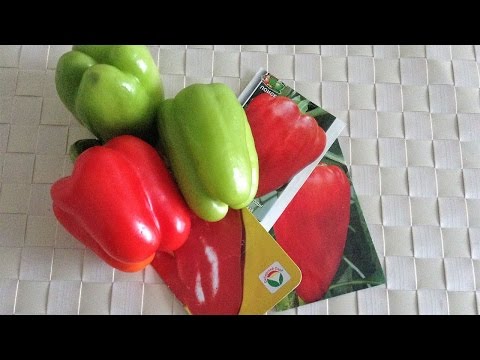

Watch this video on YouTube
Types and varieties of pepper
It has already been mentioned above that vegetable peppers are divided into bitter and sweet. Sweet peppers have the following varieties:
- bell pepper;
- cone-shaped vegetable pepper;
- bell-shaped vegetable pepper;
- tomato-shaped vegetable pepper;
- cylindrical vegetable pepper.
Also, all varieties of sweet peppers are divided into varieties for cultivation in a greenhouse, for open ground and for containers (they are grown on a windowsill or balcony, while the bushes regularly bear fruit).
Also, the varieties are divided according to the ripening period:
- early ripening ripens in 80–100 days (varieties - Zdorov'e, Dobrynya Nikitich, Snow White, Swallow; hybrids - Atlantic, Orange miracle, Montero, Cardinal, Denis);
- the average ripening period reaches maturity in 115–130 days (varieties - Prometey, Ilya Muromets, Korenovsky, Belozerka; hybrids - Maxim and Vitamin);
- late-ripening varieties ripen in 140 days or longer (the Gold Medal variety and the Nochka hybrid are popular).
It should be remembered that seeds harvested from the fruits of hybrid varieties are not able to retain the varietal characteristics of the parent plant. That is why hybrid seeds must be purchased annually.The advantage of hybrids is that they are high-yielding, have very large and tasty fruits, and high resistance to diseases.
Still, all varieties are divided according to the shape and size of the fruit, and this must be taken into account when choosing a seed. The fact is that thick-walled large fruits, the shape of which is spherical or oval, are well suited for stuffing, while it is recommended to use thin-walled varieties with not very large peppers for preparing salads. Fruits are divided in shape into cubic, oval, cylindrical, elongated, conical and spherical. There are also peppers with a lumpy or smooth surface.
And the varieties are distinguished by the color of the peppers at the stage of biological maturation:
- red peppers in varieties - Alyosha Popovich, Red Elephant, Swallow, Ilya Muromets, Winnie the Pooh and hybrids - Zarya, Latino and Red Baron;
- yellow peppers in varieties - Katyusha, Yellow bouquet, as well as hybrids - Raisa, Isabella, Indalo.
It is also interesting to know that the Maxim hybrid at technical ripeness has purple fruits, and at biological ripeness - dark red. In the Cardinal hybrid, the peppers are purple; in the Bonus variety, fruits can be colored in various shades from dark red to ivory; the hybrid Chanterelle and the Apricot Favorite variety have rich orange fruits.
The most popular varieties:
Fat Baron
This early variety has cuboid fruits with a red color and sweet taste. They weigh about 0.3 kg. The height of the spherical bush is from 0.5 to 0.6 m, 8 or 9 fruits can grow on it.
Red shovel
The height of the bush is about 0.7 m, up to 15 sweet peppers of red color can grow on them, they weigh about 150 grams, and their walls are about 0.8 cm thick.
California miracle
This mid-early variety has been known for a very long time, it ripens in about 75 days from the moment the seedlings are transplanted into open soil. The bush reaches 0.8 m in height. The thick-walled fruits are red in color, they weigh about 250 grams.
Yellow bell
This variety is the earliest and most resistant to diseases of all, it ripens only 65–70 days. Bushes reach 0.7-0.8 m in height, golden-yellow peppers are cuboid in height and can reach 12 centimeters in diameter, wall thickness from 0.8 to 1 cm.
Hybrid series Star of the East
The mass of thick-walled fruits is 150-350 grams, most of the varieties are early ripening. The fruits can be red-white, chocolate, white or golden in color.
Tevere
A medium-ripening hybrid. The yellow sweet fruits are thick-walled and weigh about 0.3 kg.
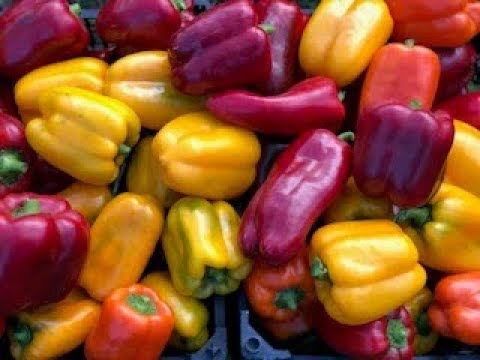

Watch this video on YouTube

